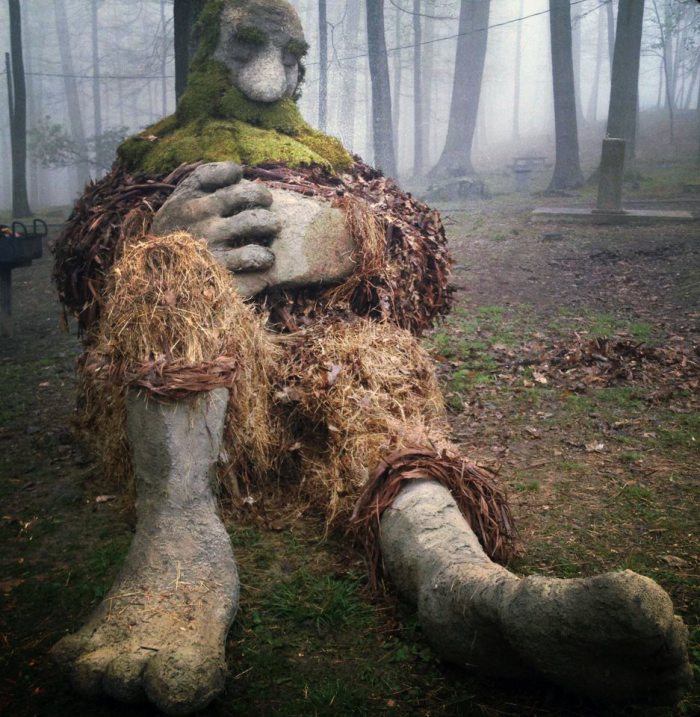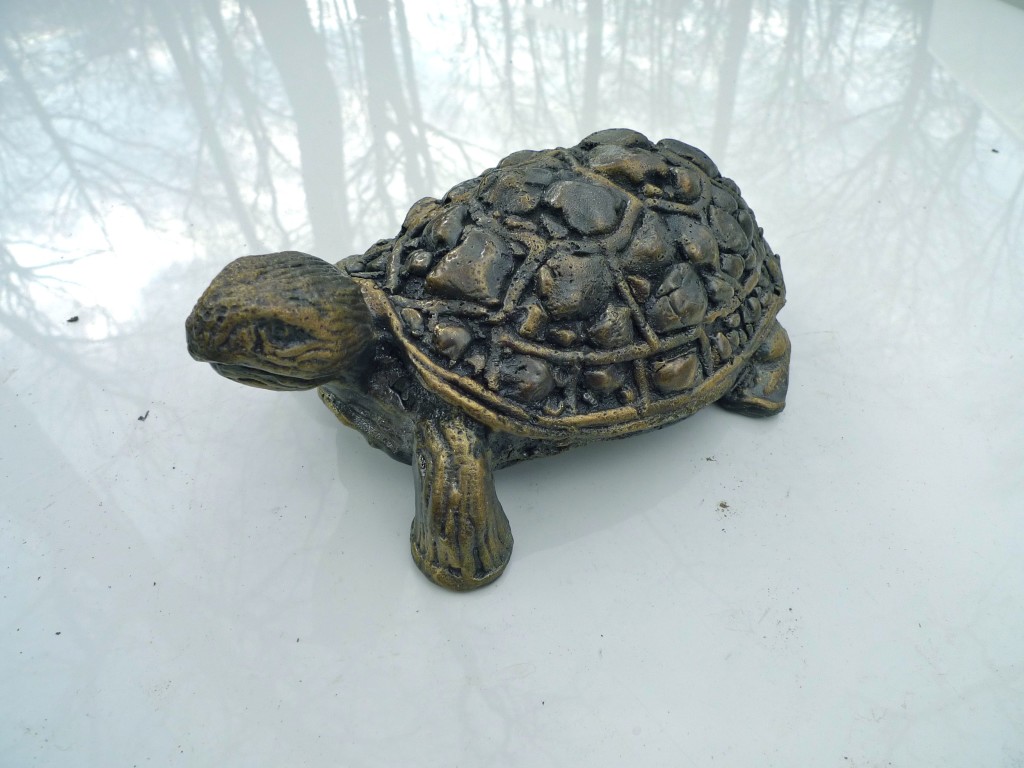We’re republishing one of our favorite artist interviews today – originally posted on April 22, 2014.
Ben Gazsi is an artist who may be best known for his eco-sculptures, but before we delve into his work, let’s get one thing out of the way. Yes, his given name really is Benjamin Gazsi; it’s a Hungarian name, not a political statement related to incidents in the Libyan city. And get this, he’s not the only Ben Ghazi (different spelling intentional) to be asked such questions. So, on with the art then?
I discovered Ben’s work while preparing for our camping trip to Cooper’s Rock State Forrest. I knew that his bear sculpture was still standing and was excited to see it and take a few pictures while we were there. As luck would have it, Ben was in the forest working on his next installation for Cooper’s Rock: a turtle that is being unveiled today, Earth Day 2014! Of course I couldn’t pass up the chance to photograph his process and ask a few questions.
Ben is currently a senior at West Virginia University, and it was a figure sculpturing class that required a public project combined with inspiration from the work of Andrew Goldsworthy that inspired his first eco-sculpture. That assignment produced the Copper’s Rock Sleeping Giant for Earth Day 2012. In the two years since, Ben’s portfolio of eco-sculptures now includes five pieces of jaw-dropping work including that aforementioned turtle, and he’s learned quite a bit along the way.
His work for each sculpture begins in the studio where he creates a prototype that is a perfectly scaled down version of the final piece. He relies on the prototype daily as a reference for both design and size. The first sleeping giant’s prototype was made from wire and later ones from plasticine, but days of transport back and forth from the site did a number on them. This year he cast the turtle in iron, and that alone is a beautiful representation of the animal.
With the prototype in hand, work on the site begins with the collection of materials. Branches are hammered into the ground and erected to provide the foundation and framing structure that will support the weight of the final piece. Wild grapevines are tied to the foundation pieces and woven together to create a three-dimensional frame that is then filled with leaves and hay. Molded chicken wire covered in hypertufa, a natural concrete, was used to create the sleeping giants’ feet, hands, and face, the rock the bear is standing on, and the turtle’s shell. Lucky for us, Ben sets up a camera on the site and creates a time lapse video of the construction process. The video below documents the bear’s creation, while he should have the turtle video ready in a couple of weeks.
After three sculptures in Cooper’s Rock, Ben now knows where exactly to look for the materials he needs. The grapevine is invasive, and the park staff do a great job of keeping it out of the camping, hiking, and day areas that receive a lot of use, but it can still be found in the lower elevations with a lot of water. He also has a tree that died a couple of years ago, but isn’t lying on the ground; creating the perfect conditions to dry out the branches, that he’ll use as support pieces, without rotting. This year, almost all of his materials, including the rocks used for the turtle’s shell came from Raven’s Rock trail.
Aside from differences in subject, the sculptures are each unique in other ways. Both sleeping giants have moss beards that were sewn on. Fallen hemlock branches were woven through the bear’s frame. During hurricane Sandy, a lot of hemlocks fell in the forest, but those branches have stored energy in them that would allow them to greening up one more time, and in this case it was just in time for the bear’s Earth Day unraveling last spring. The turtle’s shell design will be created with rocks collected from the State Forest.
When I caught up with Ben in early April, he had just finished driving the foundational branches into the ground and was in the process of attaching the first couple of rounds of grapevine. He was so patient with a stranger interrupting his work (and coming back the next day with a recorder!), answering my naive questions about everything from his process to his plans after graduation. But, it took Calder to ask the hard-hitting questions about his name.
Being so taken by his working, it was interesting to hear about his experience participating in Grand Rapid’s 2013 ArtPrize competition. ArtPrize requires entrants to partner with a venue that will host their work during the competition. Ben had contacted a number of parks without success when he was approached by the Grand Rapid’s Public Museum. With a site in place, he turned his attention to a new challenge: creating the giant in West Virginia and transporting it to Michigan. Cue the moving van. Once installed, this sleeping giant was right at home along the river with his fishing pole in hand and line in the river.
Out of over 1,500 entries, Ben’s giant earned him a spot as one of the top ten finalists. His standing and the public’s fondness for his sculpture made him a local celebrity for a few days, and with that, he sat down for a number of interviews. Like any true artist, he realized that creating the art was much more fun than talking about it. Leading up to the final judging, a public pole put Ben in 2nd place, but when the final judging was complete, Ben came in a respectable 6th place.
Through the ArtPrize process, Ben also received a taste of the tension that large competitions like this can create in the art world. With some arguing that the art receiving the most attention was the material that was easy for the public to digest, while the fine art entrants were not getting the attention they deserved.
Ben and I talked a little bit more about this. He had no problems with the controversy in the air during ArtPrize 2013, commenting that it’s a public art competition, and that he created his sculpture with a public audience in mind. ArtPrize isn’t the only forum where he’s experienced the atmosphere of criticism that comes with creating art. Ben began his college career as an architecture student, but quickly realized that the generally unfriendly and cutthroat culture was not for him. This past year Ben was busy applying to, and being wait-listed by a number of MFA programs. The problem? Schools were looking for a broader portfolio of art that stretched beyond the realism of his eco-scultpures and into the abstract.
Personally, I liked the nature of his work because it has the power to draw the lay-person in. Once you have someone’s attention with a piece like this, they may learn about the process from the collection of materials on-site to the eventual, intended decay of these sculptures over time. A piece like this has the power to bring people out to the state forest, to get them excited about nature, and to put a concrete picture in their head that they keep thinking about long after they leave.
At the end of the day, Ben enjoys creating large-scale “land art” for public consumption and he hopes to make a career of this work. There’s no question that he is off to a great start. The day we talked, he was off to a meeting at the West Virginia Botanic Garden where his first bird eco-sculpture is scheduled to be unveiled at their special event called “Ben, BBQ, and Bluegrass”. How awesome is that?
And about grad school? Ben’s heading to an MFA program in upstate New York this fall where he plans to focus on painting; he’s got the land art down, it’s time to expand his skill set.













Wow, those sculptures look like such hard work to create! I would love to wander upon one of his giants in the forest somewhere, so magical.
I know, right?! Especially stumbling upon a snoozing giant in the early morning fog.